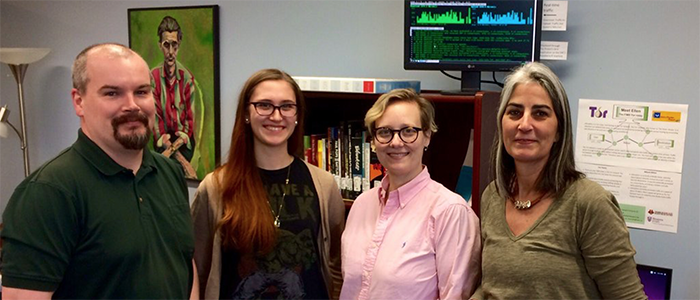FIMS News
Contact Information
FIMS Communications
Becky Blue
Email
519-661-2111x88493
FIMS & Nursing Building
Rm 2060C
Library in FIMS joins global network fighting back against digital surveillance, censorship, and the obstruction of information

March 14, 2016: In a first for Canadian libraries, the Graduate Resource Centre (GRC) in the Faculty of Information & Media Studies (FIMS) launched a Tor relay service this week linking it to a global network of servers that allow for anonymous, encrypted web browsing, and improve access to information around the world.
With public concern growing over digital surveillance and the large-scale collection of user data, the relay will contribute to restoring privacy and access to information for Tor users, including those for whom information is restricted or censored by their home governments.
The project took shape after a visit and workshop from Library Freedom Project’s Alison Macrina in early February. Students, staff and faculty came together around the initiative, which was designed to both provide a service to the wider community while giving students hands-on, experiential learning opportunity around information and data privacy.
“We know information privacy is important to our students, many of whom are currently or will be librarians or other information professionals,” said Sarah T. Roberts, Assistant Professor and an adviser on the project. “Students have been clamoring for opportunities to build their technical skills in this area, while also adhering to the principles of librarianship that support private and unfettered access to information. This endeavor unites both.”
Master of Library & Information Science (MLIS) student and Computing Services Student Assistant Lindsay Taylor agrees. “Because today’s information exchanges are so reliant on the technological systems we use, I think it’s really important for information professionals to know how they work. We need to understand how privacy breaches occur, through surveillance and data insecurity, so that we can prevent them, for our patrons and for ourselves.”
Tor technology works by connecting users around the world who allow their servers to act as open relay points through which information can travel and be shared. In conjunction with using open source software, this allows data to bypass corporate entities such as Google and Microsoft, who collect information about users, and leave it open to surveillance.
The GRC’s Tor relay is part of a larger campaign to train students in open source software and in the use of privacy and data-security tools. “These efforts speak to the foundational values of the library profession,” according to Marni Harrington, GRC Librarian, where the Tor relay is physically hosted. Students have the opportunity to work on the Tor relay instance, and the open-source workstation it runs on, through a variety of guided activities designed to enhance technical competency and data privacy knowledge.
“Given the informational marketplace in which we anticipate our students will work and live, this initiative is critically important to student preparation,” says Roberts. “In addition, the FIMS community is now assisting people around the globe who do not enjoy the same kind of access to information and privacy protections that we do in Canada. To us, this is a win for everybody.”
The efforts are being supported by FIMS Computer Services member Matt Ward, who says, “From a technical standpoint, a Tor relay is not difficult to set up and doesn’t require much computer power. A 2009-era desktop is running the Ubuntu OS with torproject.org software, with a limit on bandwidth that can be used by the server.”
Read additional coverage of the GRC's Tor relay on BoingBoing.


